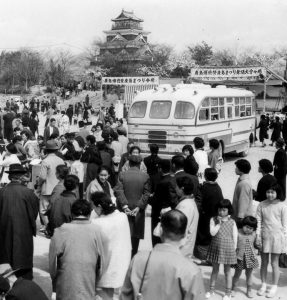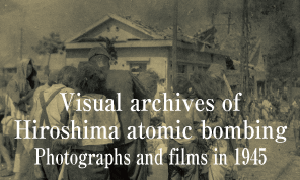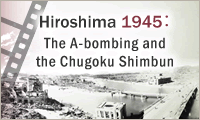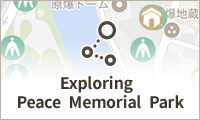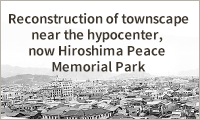Documenting Hiroshima 80 years after A-bombing: On April 1, 1958, Hiroshima Restoration Exposition opens
Mar. 29, 2025
Public relations appeal for “peaceful use” of atomic energy
by Minami Yamashita, Staff Writer
On April 1, 1958, marked the beginning of the Hiroshima Restoration Exposition, sponsored by the Hiroshima City government. Thirty pavilions focusing on such themes as “life and culture,” “tourism,” and “international” were set up in various parts of the city until May 20, showcasing the recovery of industry and culture in the city. The exposition proved to be a great success, with ticket sales totaling around 927,000, a number that exceeded expectations.
The city’s population, around 130,000 people in November 1945 after the atomic bombing, had increased to around 400,000 by the time of the expo. The main tower of Hiroshima Castle, located in the area of Motomachi (in the Hiroshima’s present-day Naka Ward), which had collapsed from the A-bomb blast, was turned into a local museum in time for the expo after being rebuilt with reinforced concrete.
Satoshi Uchi, 81, a resident of Hiroshima’s Nishi Ward who was a junior high-school student at the time he paid a visit to the expo, said, “I saw a three-wheeled truck made by Toyo Kogyo (present-day Mazda Motor Corporation) and other exhibits and was completely amazed by what was on display. In any event, the expo was just packed with people.” However, recovery of the city was ongoing, with shacks still standing nearby. Mr. Uchi added, “I still remember that my two friends and I got lost in the rows of shacks on our way back and had tears streaming down our faces.”
Models in museum
During the Hiroshima Restoration Exposition, the Hiroshima Peace Memorial Museum was used as the Nuclear Energy Science Pavilion. A model of a nuclear reactor and other items were displayed under the theme “peaceful use of nuclear energy.” There was a match-striking demonstration using an American-made mechanical arm called “Magic Hand,” a technology used to handle radioactive materials by remote control.
In May and June 1956, prior to the Hiroshima Restoration Exposition, the Atoms for Peace Exhibit (on the peaceful use of nuclear energy) was held at the Peace Memorial Museum. The United States, a nuclear superpower striving to maintain its supremacy even in the peaceful use of nuclear energy, took the lead in the project. The United States held the exhibit in the capitalist bloc (Western) of countries, holding it in Japan in such cities as Tokyo and Osaka jointly with local governments and news organizations starting in 1955.
In Hiroshima, the exhibit was co-sponsored by the Hiroshima Prefectural and City governments, Hiroshima University, the Hiroshima American Cultural Center (ACC), which was part of the U.S. Information Agency, and the Chugoku Shimbun, drawing around 110,000 visitors. A letter from U.S. President Dwight D. Eisenhower, who proposed the idea of “Atoms for Peace” in his address to the United Nations in 1953, was displayed at the exhibit venue. The letter indicated President Eisenhower’s sense that the Atoms for Peace Exhibit demonstrated the mutual determination of the two countries to contribute the great power of the atom to peaceful technology into the future.
Meanwhile, A-bombed artifacts thought to potentially elicit anti-nuclear or anti-American sentiment were moved from the museum to the Hiroshima Central Public Hall. According to a previous article on a roundtable discussion published in the Chugoku Shimbun newspaper (evening edition, dated March 22, 1956), the head of the city’s Industry Bureau explained that the “U.S. Information Agency (USIA) had requested the items be relocated because displaying them could alter the aim of the exhibit.” Abol Fotouhi, chair of the ACC, said that the aim of the exhibit was to show “only peaceful uses” of the atom, not “negative aspects of atomic bombs.”
Doubts about exhibit
The Chugoku Shimbun article also reported on doubts surrounding the Atoms for Peace Exhibit. Yuko Yamaguchi, a member of a support group for A-bomb orphans in Hiroshima City, worried that the exhibit “might erode the motivation of young people to ban atomic bombs.” Heiichi Fujii, who became the first secretary-general of the Japan Confederation of A- and H-Bomb Sufferers Organizations (Nihon Hidankyo) in August 1956, called for prioritizing research into medical treatment for so-called “A-bomb diseases” and expressed his “skepticism about whether atomic energy could ever be used peacefully, given the bitter experiences of A-bomb survivors.”
On the other hand, some Hiroshima and Nagasaki citizens who had experienced the atomic bombing expressed their hope that atomic energy would be used for “peace” precisely because they understood the tragic consequences of its military use. A group of six people from a Nagasaki association of young A-bombed men and women who visited the exhibit site in Hiroshima stated that, “It is our strong hope that atomic energy is used for peace not war.”
After conclusion of the exhibit, the displayed items were donated by the United States to Hiroshima City, which put them on display, together with a panorama of the scorched ruins of the city and other items showing the terrible consequences of the atomic bombing, at the Hiroshima Restoration Exposition. Hiroshima Mayor Tadao Watanabe wrote in an official report of the expo that the purpose of displaying the items “was to reaffirm the lessons of Hiroshima, reconsider what atomic energy should be, firmly ban the use of nuclear weapons, and limit the use of atomic energy to only peaceful purposes.”
The items related to the “peaceful use” of nuclear energy were displayed in the Peace Memorial Museum even after the Hiroshima Restoration Exposition had ended, finally being removed by 1967 as part of a movement to further strengthen the museum’s role in conveying the “tragedy of the A-bombed Hiroshima.”
(Originally published on March 29, 2025)



